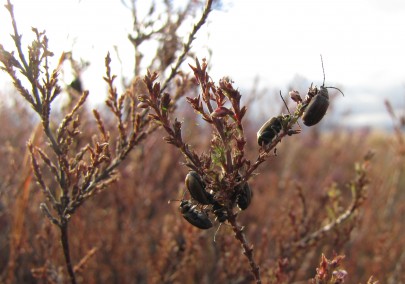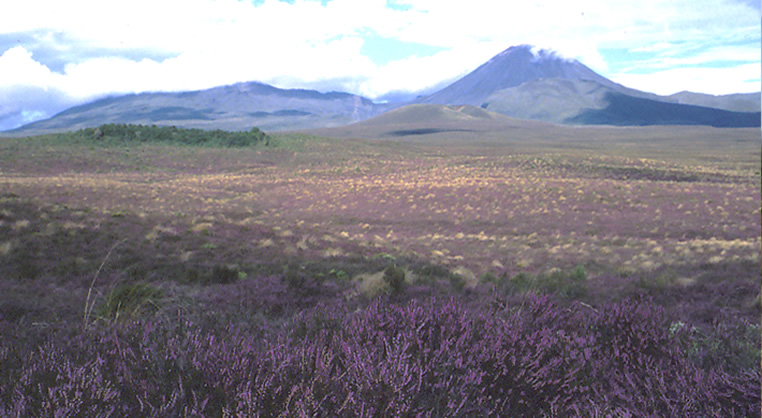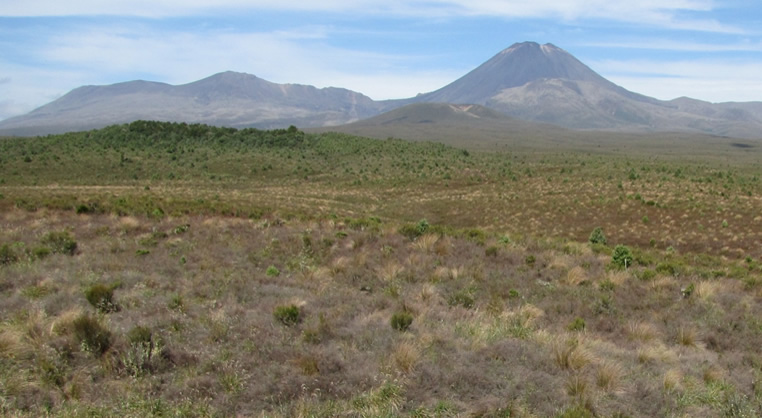Biocontrol vs Herbicides – a Case Study on Heather

Heather beetles in Tongariro National Park
Herbicides are widely used to manage invasive weeds despite their low specificity and potential for non-target impacts on native biota. They may also slow the recovery of native plant communities. On the other hand, classical biocontrol of exotic weeds poses a very low risk of non-target impacts, provided host-range testing protocols are diligently applied. Both herbicide application and biocontrol are widely used for weed management in New Zealand, but studies on their long-term ecosystem impacts (for example, community responses following control) are seldom conducted.
To help remedy this, Paul Peterson and colleagues from Manaaki Whenua – Landcare Research, Open Polytechnic and Massey University conducted a direct comparison of the efficacy and non-target impacts of biocontrol and herbicides, as well as secondary invasion, using the invasive weed heather (Calluna vulgaris) as a case study. Heather is an evergreen, woody, perennial shrub, native to Europe, Asia and North Africa, which was intentionally introduced into Tongariro National Park (TNP) in the North Island in 1912. It subsequently became the most problematic exotic plant in the park, invading more than 50 000 hectares. These heather infestations displace native flora and alter invertebrate assemblages in the park. They also disrupt military operations in NZ Defence Force land.
A biocontrol programme for heather was initiated by the Department of Conservation in 1990, which led to the release of one agent, the heather beetle (Lochmaea suturalis), in TNP in 1996. The beetle was slow to establish, although beetle outbreaks that killed patches of heather became evident from 2001. These annual beetle outbreaks, described as “slow-dispersing feeding fronts”, cause severe defoliation and die-back of heather. Around the same time, a dicot-selective herbicide (2,4-D ester) was being tested against heather in the adjacent Waiouru Military Training Area. 2,4-D ester was found to be highly effective at killing heather (90%), although non-target impacts from its use were predicted.
Damage caused by heather beetle outbreaks combined with the periodic application of 2,4-D ester for heather control provided an ideal opportunity to compare these two management strategies. A 5-year field trial initiated in 2007 measured the impacts of biocontrol and herbicides on heather and native flora, and monitored plant community responses. The randomised block design experiment with four treatments and six replicates included: (1) a biocontrol plot exposing heather plants to beetle herbivory; (2) a herbicide plot, treated with herbicide and an insecticide, to exclude beetle herbivory; (3) a biocontrol and herbicide plot with plants exposed to beetle herbivory and herbicide; and (4) a control plot, treated only with an insecticide to exclude the beetles. The herbicide and insecticide treatments were reapplied as necessary throughout the study period. Each February from 2008 to 2012 the percentage cover of all vascular and non-vascular (bryophytes, clubmosses and lichens) plants growing in the subplots was visually assessed.
“The results showed that biocontrol and herbicide were nearly equally effective at reducing heather cover,” said Paul, who led the research project. “Biocontrol reduced heather cover by 97% and herbicides by 87%. This was in comparison to a 20% increase in heather when no control methods were applied,” he added. Both control methods were effective at preventing a resurgence of the weed during the study period. “We found no differences between the two control methods when we examined their impacts on monocots (grasses) at the site. Monocots, both native and exotic, increased in percentage cover and species richness following reductions in heather from biocontrol and herbicides,” explained Paul.
The key difference between the two control methods became apparent when the researchers analysed the response of native dicots in the ecosystem. Native dicots, the most species-rich group, increased by 20% after five years following successful biocontrol. Exotic dicots also increased following biocontrol. In contrast, the dicot-selective herbicide had major non-target impacts on native (and exotic) dicots, significantly reducing their percentage cover and species richness. Consequently, secondary invasion by other exotic plant species after heather control was greatest after biocontrol due to the increase in exotic dicots, whereas the herbicide eliminated all dicot species. “Despite the fact that secondary invasion was greatest after biocontrol, the overall ecosystem benefits from biocontrol were still greater because of the recovery of native flora,” explained Paul.
However, predicting long-term ecosystem recovery is difficult, and the persistence of secondary invaders may depend on several factors. The rapid die-back and removal of heather in this study system made space for other species to invade and exploit a flush of nitrogen into the system from decaying heather. Other research has shown that this type of scenario typically favours rapid-germinating, fast growing and nutrient-loving early colonisers. The native plant community in TNP and the WMTA is slow growing by contrast, having evolved in nutrient-deficient volcanic soils and harsh environmental conditions. In light of this, the authors hypothesise that after the nutrient flush from decaying heather is exhausted, the exotic early colonisers will decline and be outcompeted by native species better adapted to the local conditions, resulting in increased resilience to further invasion.
This was one of only a few studies to experimentally compare the efficacy of biocontrol and herbicides in conjunction with quantifying non-target impacts and benefits to biodiversity after successful control. The study clearly demonstrated the safety and efficacy of biocontrol for the management of exotic weeds, and that biocontrol optimises ecosystem recovery compared to herbicides. An added advantage of biocontrol is that the agents persist and disperse, reaching other target weed infestations not actively managed.
Further reading:
Peterson PG, Merrett MM, Fowler SV, Barrett DP, Paynter Q 2020. Comparing biocontrol and herbicide for managing an invasive non-native species: efficacy, non-target effects and secondary invasion. Journal of Applied Ecology. doi:10.1111/1365-2664.13691
The Journal of Applied Ecology’s October Editor’s choice summary of the article is available at https://appliedecologistsblog.com/2020/10/01/editors-choice-5710/.
Funding
This project was funded by the Ministry of Business, Innovation and Employment’s Strategic Science Investment Fund as part of Manaaki Whenua – Landcare Research’s Beating Environmental Weeds Programme.
Key contact



